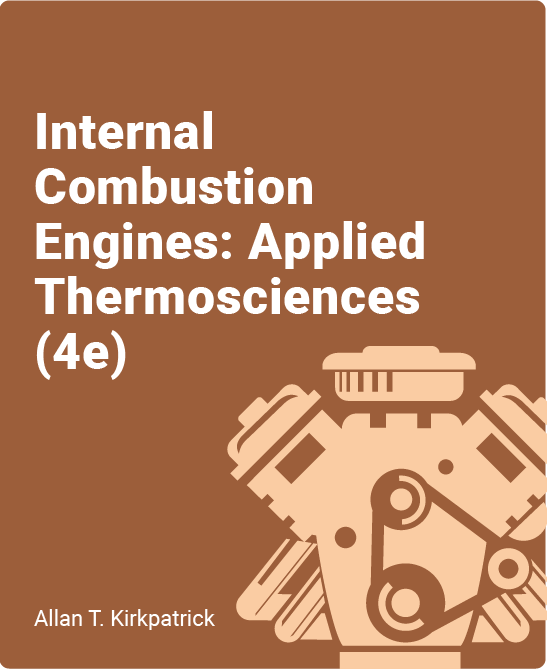Table of Contents
1. Introduction to Internal Combustion Engines 1
1.1 Introduction 1
1.2 Historical Background 4
1.3 Engine Cycles 6
1.4 Engine Performance Parameters 10
1.5 Engine Configurations 21
1.6 Examples of Internal Combustion Engines 25
1.7 Alternative Powertrain Technology 29
1.8 Further Reading 33
1.9 References 33
1.10 Homework 33
2. Ideal Gas Engine Cycles
2.1 Introduction
2.2 Gas Cycle Energy Addition
2.3 Constant Volume Energy Addition
2.4 Constant Pressure Energy Addition
2.5 Limited Pressure Cycle
2.6 Miller Cycle
2.7 Ideal Four-Stroke Process and Residual Fraction
2.8 Finite Energy Release
2.9 References
2.10 Homework
3. Thermodynamic Properties of Fuel–Air Mixtures
3.1 Introduction
3.2 Properties of Ideal Gas Mixtures
3.3 Liquid–Vapor–Gas Mixtures
3.4 Stoichiometry
3.5 Chemical Equilibrium
3.6 Low Temperature Combustion Modeling
3.7 Chemical Equilibrium Using Lagrange Multipliers
3.8 Chemical Equilibrium Using Equilibrium Constants
3.9 Isentropic Compression and Expansion
3.10 Chemical Kinetics
3.11 References
3.12 Homework
4. Thermodynamics of Combustion
4.1 Introduction
4.2 First-Law Analysis of Combustion
4.3 Second-Law Analysis of Combustion
4.4 Fuel–Air Otto Cycle
4.5 Four-Stroke Fuel–Air Otto Cycle
4.6 Limited-Pressure Fuel–Air Cycle
4.7 Two-Zone Finite-Energy Release Model
4.8 Compression Ignition Engine Fuel–Air Model
4.9 Comparison of Fuel–Air Cycles with Actual Spark and Compression Ignition Cycles
4.10 Further Reading
4.11 Homework
5. Intake and Exhaust Flow
5.1 Introduction
5.2 Flow Through Intake and Exhaust Valves
5.3 Intake and Exhaust Manifold Flow
5.4 Airflow in Two-Stroke Engines
5.5 Superchargers and Turbochargers
5.6 Further Reading
5.7 References
5.8 Homework
6. Fuel and Air Flow in the Cylinder
6.1 Introduction
6.2 Fuel Injection – Spark Ignition
6.3 Fuel Injection – Compression Ignition
6.4 Fuel Sprays
6.5 Gaseous Fuel Injection
6.6 Prechambers
6.7 Carburetion
6.8 Large-Scale In-Cylinder Flow
6.9 In-Cylinder Turbulence
6.10 Further Reading
6.11 References
6.12 Homework
7. Combustion Processes in Engines
7.1 Introduction
7.2 Combustion in Spark-Ignition Engines
7.3 Abnormal Combustion (Knock) in Spark-Ignition Engines
7.4 Combustion in Compression Ignition Engines
7.5 Low Temperature Combustion
7.6 Further Reading
7.7 References
7.8 Homework
8. Emissions
8.1 Introduction
8.2 Nitrogen Oxides
8.3 Carbon Monoxide
8.4 Hydrocarbons
8.5 Particulates
8.6 Emissions Regulation and Control
8.7 Further Reading
8.8 References
8.9 Homework
9. Fuels
9.1 Introduction
9.2 Refining
9.3 Hydrocarbon Chemistry
9.4 Thermodynamic Properties of Fuel Mixtures
9.5 Gasoline Fuels
9.6 Alternative Fuels for Spark-Ignition Engines
9.7 Diesel Fuels
9.8 Further Reading
9.9 Homework
10. Friction and Lubrication
10.1 Introduction
10.2 Friction Coefficient
10.3 Engine Oils
10.4 Friction Power and Mean Effective Pressure
10.5 Friction Measurements
10.6 Friction Scaling Parameters
10.7 Piston and Ring Friction
10.8 Journal Bearings
10.9 Valve Train Friction
10.10 Accessory Friction
10.11 Pumping Mean Effective Pressure
10.12 Overall Engine Friction Mean Effective Pressure
10.13 Further Reading 432
10.14 References 432
10.15 Homework 433
11. Heat and Mass Transfer
11.1 Introduction
11.2 Engine Cooling Systems
11.3 Engine Energy Balance
11.4 Heat Transfer Measurements
11.5 Heat Transfer Modeling
11.6 Heat Transfer Correlations
11.7 Radiation Heat Transfer
11.8 Heat Transfer in the Exhaust System
11.9 Mass Loss or Blowby
11.10 Further Reading
11.11 References
11.12 Homework
12. Engine Instrumentation and Testing
12.1 Introduction
12.2 Instrumentation
12.3 Combustion Analysis
12.4 Exhaust Gas Analysis
12.5 Control Systems in Engines
12.6 Vehicle Emissions Testing
12.7 Further Reading
12.8 References
12.9 Homework
13. Overall Engine Performance
13.1 Introduction
13.2 Effect of Engine Size, Bore, and Stroke
13.3 Effect of Engine Speed
13.4 Effect of Air–Fuel Ratio and Load
13.5 Engine Performance Maps
13.6 Effect of Ignition and Injection Timing
13.7 Effect of Compression Ratio
13.8 Vehicle Performance Simulation
13.9 Further Reading
13.10 References
13.11 Homework
Appendices
A Conversion Factors and Physical Constants
B Physical Properties of Air
C Thermodynamic Property Tables for Various Ideal Gases
D Curve-Fit Coefficients for Thermodynamic Properties of Various Fuels and Ideal Gases
E Detailed Thermodynamic and Fluid Flow Analyses
E.1 Thermodynamic Derivatives
E.2 Numerical Solution of Equilibrium Combustion Equations
E.3 Isentropic Compression/Expansion with Known ΔP
E.4 Isentropic Compression/Expansion with Known Δv
E.5 Constant Volume Combustion
E.6 Quality of Exhaust Products
E.7 Finite Difference Form of the Reynolds Slider Equation
E.8 Reference
F Computer Programs
F.1 Volume.m
F.2 Velocity.m
F.3 BurnFraction.m
F.4 FiniteHeatRelease.m
F.5 FiniteHeatMassLoss.m
F.6 CIHeatRelease.m
F.7 FourStrokeOtto.m
F.8 RunFarg.m
F.9 farg.m
F.10 fuel.m
F.11 RunEcp.m
F.12 ecp.m
F.13 AdiabaticFlameTemp.m
F.14 OttoFuelAir.m
F.15 FourStrokeFuelAir.m
F.16 TwoZoneFuelAir.m
F.17 Fuel_Injected.m
F.18 LimitPressFuelAir.m
F.19 ValveFlow.m
F.20 Droplet.m
F.21 Kinetic.m
F.22 Soot.m
F.23 TwoZoneNO.m
F.24 RingPressure.m
F.25 Friction.m
F.26 HeatTransfer.m
Index
zyText are leading print textbooks available in full on the zyBooks platform. Each zyText has been adapted to include learning questions and answer-specific feedback allowing for a quick and easy transition to an engaging digital experience for instructors and students.
What You’ll Find in this zyText:
- Incorporates the complete text
- Over 150 learning questions with answer-specific feedback
- Customization tools letting you add, remove or reorder chapters and sections
- Options to align the book directly to your syllabus – including videos, images, text
- Analytics that help you measure student engagement
- Ability to hold students accountable for reading before class.
- A competitive low price point.
- Students can keep a PDF version of key chapters at no additional cost
A comprehensive resource covering the foundational thermal-fluid sciences and engineering analysis techniques used to design and develop internal combustion engines
This new 4th edition includes brand new material on:
- New engine technologies and concepts
- Effects of engine speed on performance and emissions
- Fluid mechanics of intake and exhaust flow in engines
- Turbocharger and supercharger performance analysis
- Chemical kinetic modeling, reaction mechanisms, and emissions
- Advanced combustion processes including low temperature combustion
- Piston, ring and journal bearing friction analysis
Author
Allan T. Kirkpatrick

